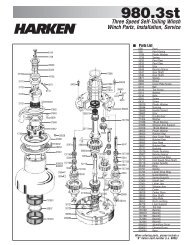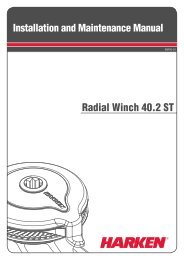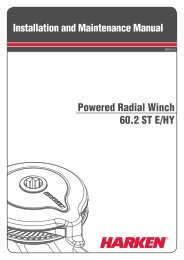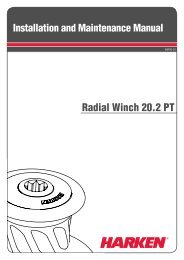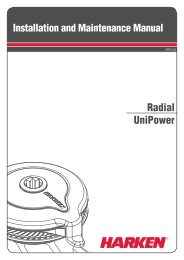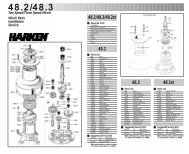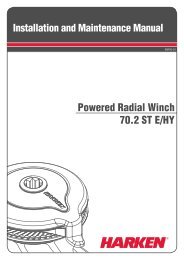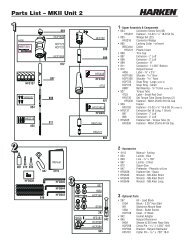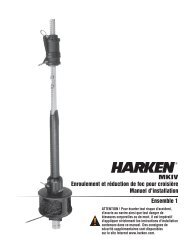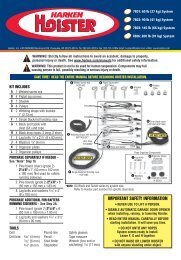Create successful ePaper yourself
Turn your PDF publications into a flip-book with our unique Google optimized e-Paper software.
Preassembly<br />
Determining Headstay Length<br />
Pin-to-pin headstay length is a measurement which is used in many steps of assembly and also for measuring<br />
sails. After determining the length of your headstay, write the length on the outside back cover of this manual for<br />
easy reference in the future.<br />
Upper and lower measurement points for headstay length.<br />
Points de mesure supérieur et inférieur.<br />
Oberer und unterer Messpunkt für Verstaglänge.<br />
Punti di misurazione superiore e inferiore dello strallo.<br />
Pin-to-pin is measured from the center of the pin<br />
holding the headstay to the masthead toggle to the<br />
center of the pin holding the headstay assembly to<br />
the stemhead chainplate.<br />
Be sure that the turnbuckle is set to the correct length<br />
before measuring. The measurement should include<br />
all turnbuckles and toggles at the lower end, but<br />
should not include the masthead toggle.<br />
All headstays must be secured to a toggle at the<br />
masthead.<br />
■ Additional Stemhead Toggles<br />
Your furling system has an integral toggle at the lower turnbuckle fitting. An<br />
additional toggle is not required at the lower end but may be fitted if the<br />
headstay wire is too short, or if it is desirable to mount the drum higher off<br />
the deck than normal, say to provide more clearance for an anchor.<br />
Should an additional toggle be fitted to the headstay, be sure to subtract the<br />
pin-to-pin length of the toggle from the overall length of the headstay.<br />
Some boats with very narrow bows or with bowsprits may find that the furling<br />
drum, in its normal position, will not fit inside the pulpit. It may be necessary<br />
to use a toggle to raise the drum to avoid these problems.<br />
The system is designed to keep the sail as close to the deck as possible. While it may be necessary to raise the drum<br />
to provide clearance for an anchor or to fit inside a pulpit, do not mount the drum higher than required. Raising the<br />
drum reduces sail luff length and increases heeling. If you need better visibility under your genoa, mount the drum<br />
as low as possible and see the instructions on page 30 of the manual.<br />
Furling units should not be mounted above turnbuckles or long link plates. If you are considering this discuss your<br />
installation carefully with <strong>Harken</strong> before proceeding.<br />
Upper<br />
Measurement<br />
Point<br />
Isomat<br />
■ Isomat Masts<br />
Isomat type masts have an unusual fitting at the top of the headstay. This "stemball" must<br />
be cut off and a special stemball adapter placed on the upper end of the headstay. This<br />
adapter, <strong>Harken</strong> part 941, may be purchased from your Jib Furling dealer or distributor.<br />
You will also need a standard marine eye which can be purchased from your rigger. This<br />
marine eye will be swaged to the upper end of the headstay.<br />
When measuring headstay length, use the center of the<br />
new eye on the wire as the upper measurement point.<br />
Upper<br />
Measurement<br />
Point<br />
■ T-Ball Fittings<br />
Some boats have T-ball swage fittings as the upper terminal. They do not require<br />
an additional toggle. Use the elbow in the fitting as the upper measurement point.<br />
See diagram.<br />
T-Ball<br />
February 2000 Unit 1 MKIII 8






